Subzero Material Properties of Advanced High-Strength Cold-Formed Steel Alloys
Abstract
:1. Introduction
2. Experimental Study
2.1. Test Apparatus
2.2. Test Materials and Specimens
2.3. Test Procedures
3. Experiment Results
3.1. Stress–Strain Curves
3.2. Material Properties
3.2.1. Elastic Modulus
3.2.2. Key Stresses
3.2.3. Key Strains and Elongations
4. Discussion on Experimental Results
4.1. Comparison of Key Material Properties
4.2. Comparison to Design Standards Ductility Requirements
5. Stress–Strain Relationship Characterization
6. Conclusions
Author Contributions
Funding
Institutional Review Board Statement
Informed Consent Statement
Data Availability Statement
Acknowledgments
Conflicts of Interest
Abbreviations
| AHSS | advanced high-strength steel |
| CFS | cold-formed steel |
| DP | dual phase |
| HSLA | high-strength low-alloy |
| HSS | high-strength steel |
| HRS | hot-rolled steel |
| MS | Martensitic |
References
- Box, J.E.; Colgan, W.T.; Christensen, T.R.; Schmidt, N.M.; Lund, M.; Parmentier, F.J.W.; Brown, R.; Bhatt, U.S.; Euskirchen, E.S.; Romanovsky, V.E.; et al. Key indicators of Arctic climate change: 1971–2017. Environ. Res. Lett. 2019, 14, 045010. [Google Scholar] [CrossRef]
- Runge, C.A.; Daigle, R.M.; Hausner, V.H. Quantifying tourism booms and the increasing footprint in the Arctic with social media data. PLoS ONE 2020, 15, e0227189. [Google Scholar] [CrossRef] [PubMed]
- Agarkov, S.A.; Kozlov, A.V.; Fedoseev, S.V.; Teslya, A.B. Major trends in efficiency upgrading of the economic activity in the arctic zone of Russian Federation. J. Min. Inst. 2018, 230, 209–216. [Google Scholar] [CrossRef]
- Smirnov, A.V. The Arctic Population: Dynamics and Centers of the Settlement System. Arct. North 2020, 40, 270–290. [Google Scholar] [CrossRef]
- Hovelsrud, G.K.; Poppel, B.; Van Oort, B.; Reist, J.D. Arctic societies, cultures, and peoples in a changing cryosphere. Ambio 2011, 40, 100–110. [Google Scholar] [CrossRef]
- Yu, W.; LaBoube, R.A.; Chen, H. Cold-Formed Steel Design, 5th ed.; John Wiley & Sons, Inc.: Hoboken, NJ, USA, 2019; pp. 1–528. [Google Scholar]
- European Committee for Standardization (CEN). Eurocode 3: Design of Steel Structures, Part 1–12: General—High Strength Steels; CEN: Brussels, Belgium, 2007. [Google Scholar]
- Schafer, B.; Bjorhovde, R.; Fahnestock, L.; Finnigan, S.; Gilsanz, R.; Griffis, L.; Leon, R.; Lepage, A.; Poulos, T.; Rassati, G.; et al. Ad Hoc Task Group Report on High Strength Steel; Technical Report; American Institute of Steel Construction: Chicago, IL, USA, 2019. [Google Scholar]
- Shin, H.S.; Lee, H.M.; Kim, M.S. Impact tensile behaviors of 9% nickel steel at low temperature. Int. J. Impact Eng. 2000, 24, 571–581. [Google Scholar] [CrossRef]
- Filiatrault, A.; Holleran, M. stress–strain behavior of reinforcing steel and concrete under seismic strain rates and low temperatures. Mater. Struct. 2001, 34, 235–239. [Google Scholar] [CrossRef]
- Levings, J.; Sritharan, S. Effects of Cold Temperature and Strain Rate on the stress–strain Behavior of ASTM A706 Grade 420(60) Steel Reinforcement. J. Mater. Civ. Eng. 2012, 24, 1441–1449. [Google Scholar] [CrossRef]
- Wang, Y.; Liu, X.; Hu, Z.; Shi, Y. Experimental study on mechanical properties and fracture toughness of structural thick plate and its butt weld along thickness and at low temperatures. Fatigue Fract. Eng. Mater. Struct. 2013, 36, 1258–1273. [Google Scholar] [CrossRef]
- Yan, J.B.; Liew, J.Y.; Zhang, M.H.; Wang, J.Y. Mechanical properties of normal strength mild steel and high strength steel S690 in low temperature relevant to Arctic environment. Mater. Des. 2014, 61, 150–159. [Google Scholar] [CrossRef]
- Furuya, H.; Tagawa, T.; Ishikawa, T. Effect of Tempering Temperature on Tensile Straining Behavior in Ni Bearing Cryogenic Steel. J. Iron Steel Inst. Jpn. 2014, 100, 104–111. [Google Scholar] [CrossRef]
- Li, Y.j.; Fu, R.d.; Li, Y.; Peng, Y.; Liu, H.j. Tensile properties and fracture behavior of friction stir welded joints of Fe-32Mn-7Cr-1Mo-0.3 N steel at cryogenic temperature. J. Mater. Sci. Technol. 2018, 34, 157–162. [Google Scholar] [CrossRef]
- Li, Z.; Zhang, D.; Wu, H.; Huang, F.; Hong, W.; Zang, X. Fatigue properties of welded Q420 high strength steel at room and low temperatures. Constr. Build. Mater. 2018, 189, 955–966. [Google Scholar] [CrossRef]
- Xie, J.; Zhao, X.; Yan, J.B. Mechanical properties of high strength steel strand at low temperatures: Tests and analysis. Constr. Build. Mater. 2018, 189, 1076–1092. [Google Scholar] [CrossRef]
- Xie, J.; Zhu, G.R.; Yan, J.B. Mechanical properties of headed studs at low temperatures in Arctic infrastructure. J. Constr. Steel Res. 2018, 149, 130–140. [Google Scholar] [CrossRef]
- Yin, Y.; Li, S.; Han, Q.; Li, M. Material parameters in void growth model for G20Mn5QT cast steel at low temperatures. Constr. Build. Mater. 2020, 243, 118123. [Google Scholar] [CrossRef]
- An, L.; Jiang, W.; Zhang, H.; Wu, J. Experimental research on bolted joint strength and dispersion in steel lattice transmission tower legs under low temperatures. Fatigue Fract. Eng. Mater. Struct. 2020, 43, 919–931. [Google Scholar] [CrossRef]
- Yan, J.B.; Luo, Y.L.; Lin, X.C.; Luo, Y.B.; Zhang, L.X. Effects of the Arctic low temperature on mechanical properties of Q690 and Q960 high-strength steels. Constr. Build. Mater. 2021, 300, 124022. [Google Scholar] [CrossRef]
- Yan, J.B.; Luo, Y.L.; Su, L.; Lin, X.; Luo, Y.B.; Zhang, L. Low-temperature compression behaviour of square CFST columns using Q960 ultra-high strength steel. J. Constr. Steel Res. 2021, 183, 106727. [Google Scholar] [CrossRef]
- Li, C.; Li, K.; Dong, J.; Wang, J.; Shao, Z. Mechanical behaviour and microstructure of Fe-20/27Mn–4Al-0.3 C low magnetic steel at room and cryogenic temperatures. Mater. Sci. Eng. A 2021, 809, 140998. [Google Scholar] [CrossRef]
- Fujimura, Y.; Ishii, H. Tensile behaviors of high Cr-low Ni two-phase stainless steels at room and low temperatures. J. Jpn. I. Met. 1973, 37, 33–39. [Google Scholar] [CrossRef] [PubMed]
- Miura, R.; Ohnishi, K.; Nakajima, H.; Shimamoto, S. Effects of carbon and nitrogen on the tensile deformation behavior of SUS304 and 316 stainless steels at cryogenic temperatures. J. Iron Steel Inst. Jpn. 1987, 73, 715–722. [Google Scholar] [CrossRef] [PubMed]
- He, J.; Han, G.; Fukuyama, S.; Yokogawa, K. Tensile behaviour of duplex stainless steel at low temperatures. Mater. Sci. Technol. 1999, 15, 909–920. [Google Scholar] [CrossRef]
- Sun, D.; Han, G.; Vaodee, S.; Fukuyama, S.; Yokogawa, K. Tensile behaviour of type 304 austenitic stainless steels in hydrogen atmosphere at low temperatures. Mater. Sci. Technol. 2001, 17, 302–308. [Google Scholar] [CrossRef]
- Park, W.S.; Yoo, S.W.; Kim, M.H.; Lee, J.M. Strain-rate effects on the mechanical behavior of the AISI 300 series of austenitic stainless steel under cryogenic environments. Mater. Des. 2010, 31, 3630–3640. [Google Scholar] [CrossRef]
- Yoo, S.W.; Lee, C.S.; Park, W.S.; Kim, M.H.; Lee, J.M. Temperature and strain rate dependent constitutive model of TRIP steels for low-temperature applications. Comput. Mater. Sci. 2011, 50, 2014–2027. [Google Scholar] [CrossRef]
- Zheng, C.; Yu, W. Effect of low-temperature on mechanical behavior for an AISI 304 austenitic stainless steel. Mater. Sci. Eng. A 2018, 710, 359–365. [Google Scholar] [CrossRef]
- Ding, H.; Wu, Y.; Lu, Q.; Xu, P.; Zheng, J.; Wei, L. Tensile properties and impact toughness of S30408 stainless steel and its welded joints at cryogenic temperatures. Cryogenics 2018, 92, 50–59. [Google Scholar] [CrossRef]
- Yan, J.B.; Lin, Z.; Xie, P.; Luo, Y.B.; Li, Y. Tensile behavior of stainless steel S30408 at the Arctic low temperature. Steel Compos. Struct. 2021, 40, 633–648. [Google Scholar] [CrossRef]
- Koga, N.; Nameki, T.; Umezawa, O.; Tschan, V.; Weiss, K.P. Tensile properties and deformation behavior of ferrite and austenite duplex stainless steel at cryogenic temperatures. Mater. Sci. Eng. A 2021, 801, 140442. [Google Scholar] [CrossRef]
- Yan, J.B.; Geng, Y.; Xie, P.; Xie, J. Low-temperature mechanical properties of stainless steel 316L: Tests and constitutive models. Constr. Build. Mater. 2022, 343, 128122. [Google Scholar] [CrossRef]
- Abdel-Rahim, A.; Polyzois, D. Effect of temperature and galvanization on cold-formed steel. J. Mater. Civ. Eng. 1996, 8, 114–122. [Google Scholar] [CrossRef]
- Nykänen, T.; Björk, T.; Mettänen, H.; Ilyin, A.; Koskimäki, M. Residual strength at −40 °C of a precracked cold-formed rectangular hollow section made of ultra-high-strength steel–an engineering approach. Fatigue Fract. Eng. Mater. Struct. 2014, 37, 325–334. [Google Scholar] [CrossRef]
- Azhari, F.; Hossain Apon, A.A.; Heidarpour, A.; Zhao, X.L.; Hutchinson, C.R. Mechanical response of ultra-high strength (Grade 1200) steel under extreme cooling conditions. Constr. Build. Mater. 2018, 175, 790–803. [Google Scholar] [CrossRef]
- Rokilan, M.; Mahendran, M. Sub-zero temperature mechanical properties of cold-rolled steel sheets. Thin-Walled Struct. 2020, 154, 106842. [Google Scholar] [CrossRef]
- Kosaraju, S.; Singh, S.K.; Buddi, T.; Kalluri, A.; Haq, A.U. Evaluation and characterisation of ASS316L at sub-zero temperature. Adv. Mater. Proc. Technol. 2020, 6, 365–375. [Google Scholar] [CrossRef]
- Yan, J.B.; Xie, W.J.; Luo, Y.; Wang, T. Behaviours of concrete stub columns confined by steel tubes at cold-region low temperatures. J. Constr. Steel Res. 2020, 170, 106124. [Google Scholar] [CrossRef]
- Mu, W.; Li, Y.; Cai, Y.; Wang, M. Low-cycle Fatigue and Fracture Behaviour of 9%Ni Steel Flux Cored Arc Welding joint at Cryogenic Temperature. MATEC Web Conf. 2019, 269, 3008. [Google Scholar] [CrossRef]
- Valtonen, K.; Ratia, V.; Ramakrishnan, K.R.; Apostol, M.; Terva, J.; Kuokkala, V.T. Impact wear and mechanical behavior of steels at subzero temperatures. Tribol. Int. 2019, 129, 476–493. [Google Scholar] [CrossRef]
- Keeler, S.; Kimchi, M.; Mooney, P. Advanced High-Strength Steels Application Guidelines; WorldAutoSteel: Brussels, Belgium, 2017. [Google Scholar]
- Kuziak, R.; Kawalla, R.; Waengler, S. Advanced high strength steels for automotive industry. Arch. Civ. Mech. Eng. 2008, 8, 103–117. [Google Scholar] [CrossRef]
- Xia, Y.; Ding, C.; Li, Z.; Schafer, B.W.; Blum, H.B. Numerical modeling of stress–strain relationships for advanced high strength steels. J. Constr. Steel Res. 2021, 182, 106687. [Google Scholar] [CrossRef]
- Yan, X.; Xia, Y.; Blum, H.B.; Gernay, T. Elevated temperature material properties of advanced high strength steel alloys. J. Constr. Steel Res. 2020, 174, 106299. [Google Scholar] [CrossRef]
- Yan, X.; Xia, Y.; Blum, H.B.; Gernay, T. Post-fire mechanical properties of advanced high-strength cold-formed steel alloys. Thin-Walled Struct. 2021, 159, 107293. [Google Scholar] [CrossRef]
- Xia, Y.; Yan, X.; Gernay, T.; Blum, H.B. Elevated temperature and post-fire stress–strain modeling of advanced high-strength cold-formed steel alloys. J. Constr. Steel Res. 2022, 190, 107116. [Google Scholar] [CrossRef]
- Weng, C.C.; Peköz, T. Residual Stresses in Cold-Formed Steel Members. J. Struct. Eng. 1990, 116, 1611–1625. [Google Scholar] [CrossRef]
- Abdel-Rahman, N.; Sivakumaran, K. Material properties models for analysis of cold-formed steel members. J. Struct. Eng. 1997, 123, 1135–1143. [Google Scholar] [CrossRef]
- Xia, Y.; Blum, H.B. Experimental study on residual stresses in press-braked advanced high-strength cold-formed steel lipped angles by sectioning method. In Proceedings of the Cold-Formed Steel Research Consortium Colloquium, Online, 17–19 October 2022. [Google Scholar]
- Koh, H.; Blum, H.B. Calibration and validation of the hole-drilling method to measure residual stresses in advanced high-strength cold-formed steel members. In Proceedings of the Cold-Formed Steel Research Consortium Colloquium, Online, 17–19 October 2022. [Google Scholar]
- American Iron and Steel Institute (AISI). S100-16 (2020): North American Specification for the Design of Cold-Formed Steel Structural Members; AISI: Washington, DC, USA, 2020. [Google Scholar]
- ASTM. E8-22 Standard Test Methods for Tension Testing of Metallic Materials; ASTM: West Conshohocken, PA, USA, 2022. [Google Scholar] [CrossRef]
- Huang, Y.; Young, B. The art of coupon tests. J. Constr. Steel Res. 2014, 96, 159–175. [Google Scholar] [CrossRef]
- Serreze, M.C.; Barry, R.G. The Arctic Climate System, 2nd ed.; Cambridge University Press: Cambridge, UK, 2014. [Google Scholar] [CrossRef]
- Vavrus, S.J.; Holland, M.M.; Jahn, A.; Bailey, D.A.; Blazey, B.A. Twenty-First-Century Arctic Climate Change in CCSM4. J. Clim. 2012, 25, 2696–2710. [Google Scholar] [CrossRef] [Green Version]
- Rogers, C.A.; Hancock, G.J. Ductility of G550 Sheet Steels in Tension. J. Struct. Eng. 1997, 123, 1586–1594. [Google Scholar] [CrossRef]
- American Iron and Steel Institute (AISI). S903-20: Test Standard for Determining the Uniform and Local Ductility of Carbon and Low-Alloy Steels; AISI: Washington, DC, USA, 2020. [Google Scholar]
- Yan, J.B.; Xie, J. Experimental studies on mechanical properties of steel reinforcements under cryogenic temperatures. Constr. Build. Mater. 2017, 151, 661–672. [Google Scholar] [CrossRef]
- European Committee for Standardization (CEN). Eurocode 3: Design of Steel Structures, Part 1–3: General Rules—Supplementary Rules for Cold-Formed Members and Sheeting; CEN: Brussels, Belgium, 2006. [Google Scholar]
- European Committee for Standardization (CEN). Eurocode 3: Design of Steel Structures, Part 1–1: General Rules and Rules for Buildings; CEN: Brussels, Belgium, 2016. [Google Scholar]
- Standards Australia. AS/NZS 1397:2021; Continuous Hot-Dip Metallic Coated Steel Sheet and Strip—Coatings of Zinc and Zinc Alloyed with Aluminium and Magnesium. Standards Australia: Sydney, Australia, 2021. [Google Scholar]
- Dhalla, A.K.; Winter, G. Suggested steel ductility requirements. J. Struct. Div. 1974, 100, 445–462. [Google Scholar] [CrossRef]
- Mirambell, E.; Real, E. On the calculation of deflections in structural stainless steel beams: An experimental and numerical investigation. J. Constr. Steel Res. 2000, 54, 109–133. [Google Scholar] [CrossRef]
- Gardner, L.; Yun, X. Description of stress–strain curves for cold-formed steels. Constr. Build. Mater. 2018, 189, 527–538. [Google Scholar] [CrossRef]
- Ramberg, W.; Osgood, W.R. Description of stress–strain Curves by Three Parameters; NACA-TN-902; National Advisory Committee for Aeronautics: Washington, DC, USA, 1943. [Google Scholar]
- Yun, X.; Gardner, L. stress–strain curves for hot-rolled steels. J. Constr. Steel Res. 2017, 133, 36–46. [Google Scholar] [CrossRef]
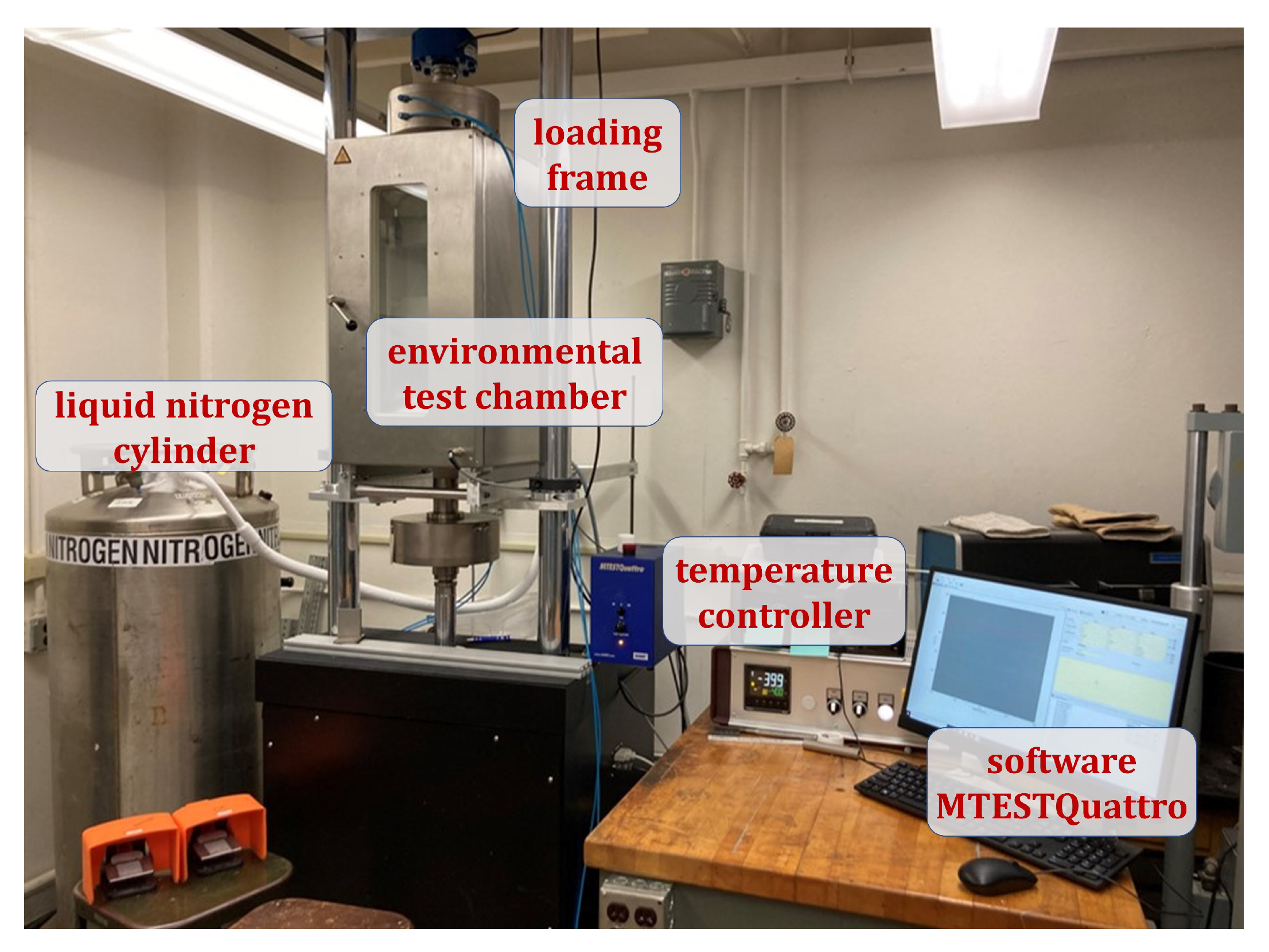


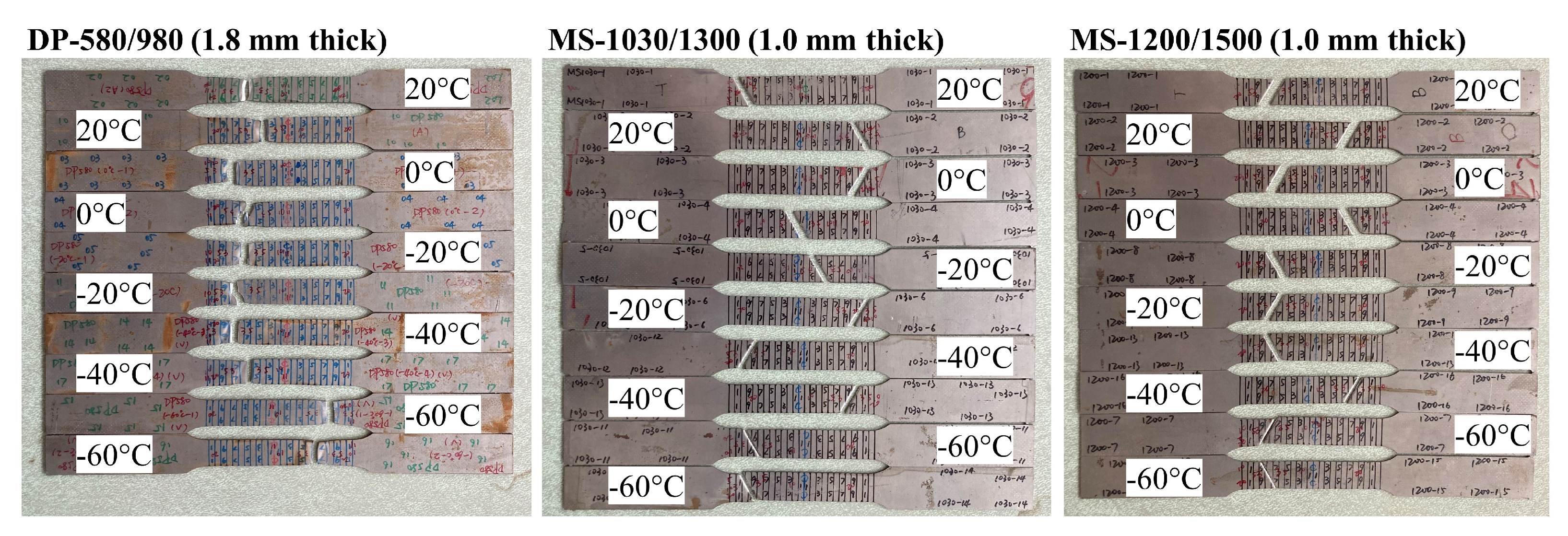
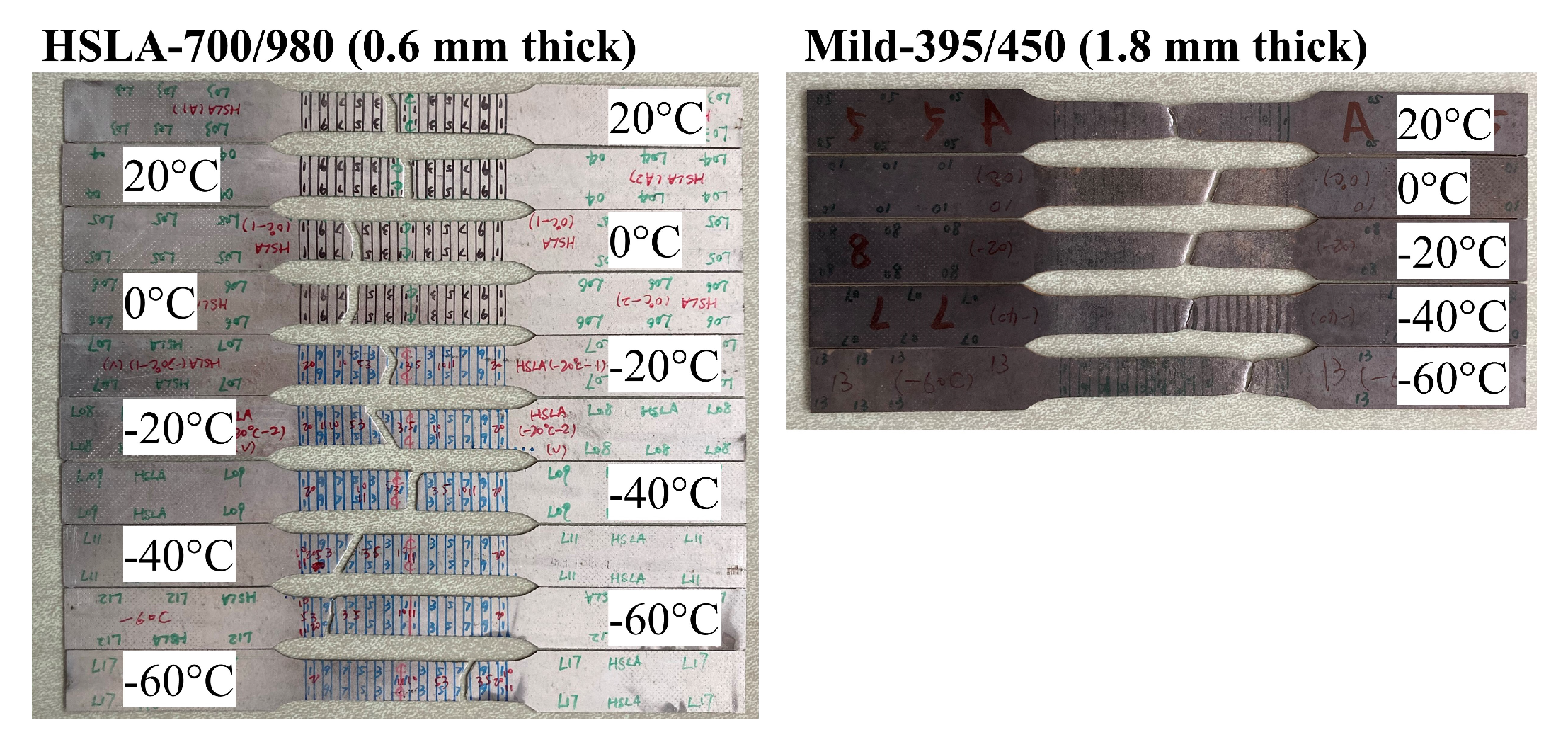
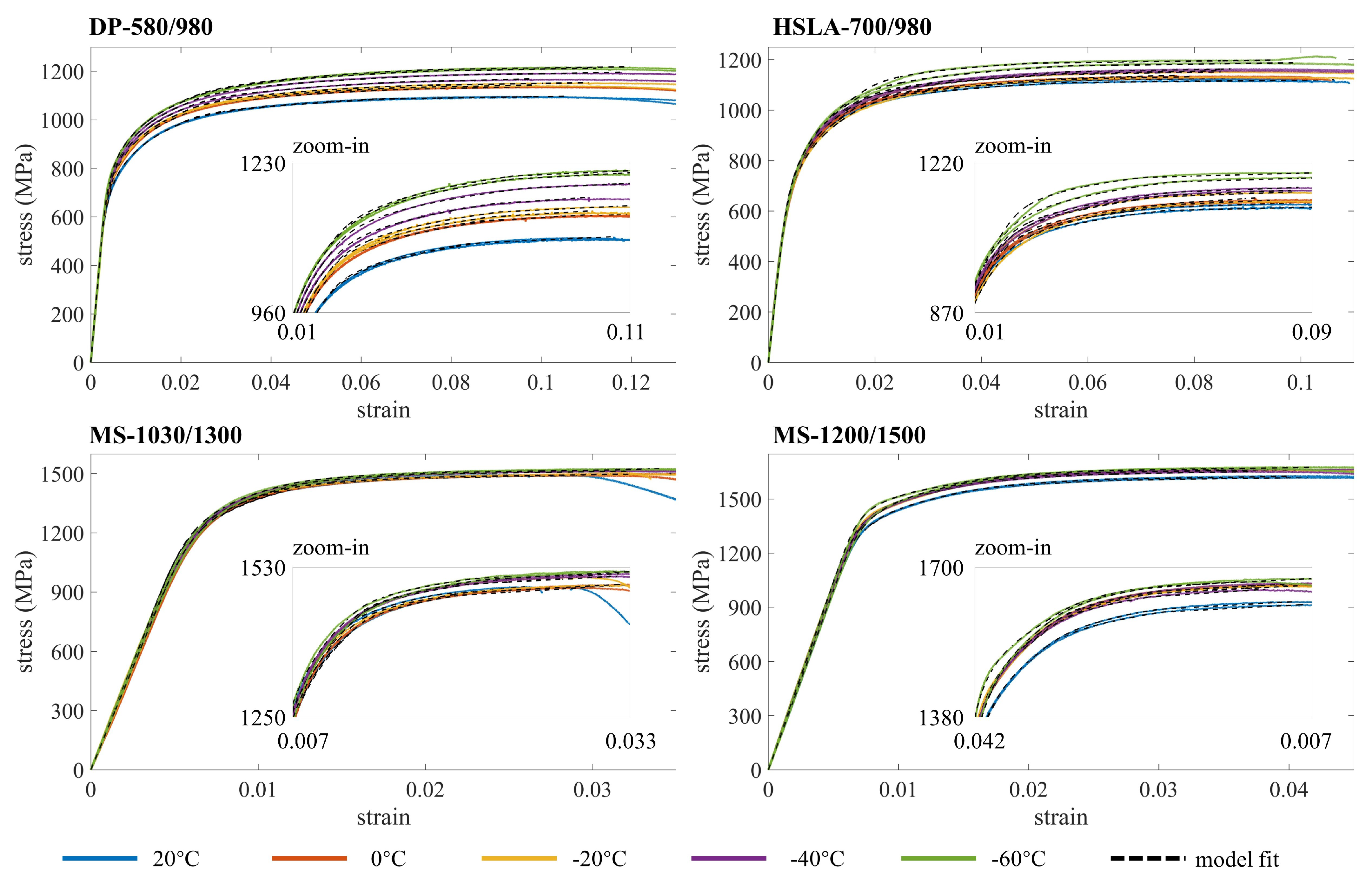
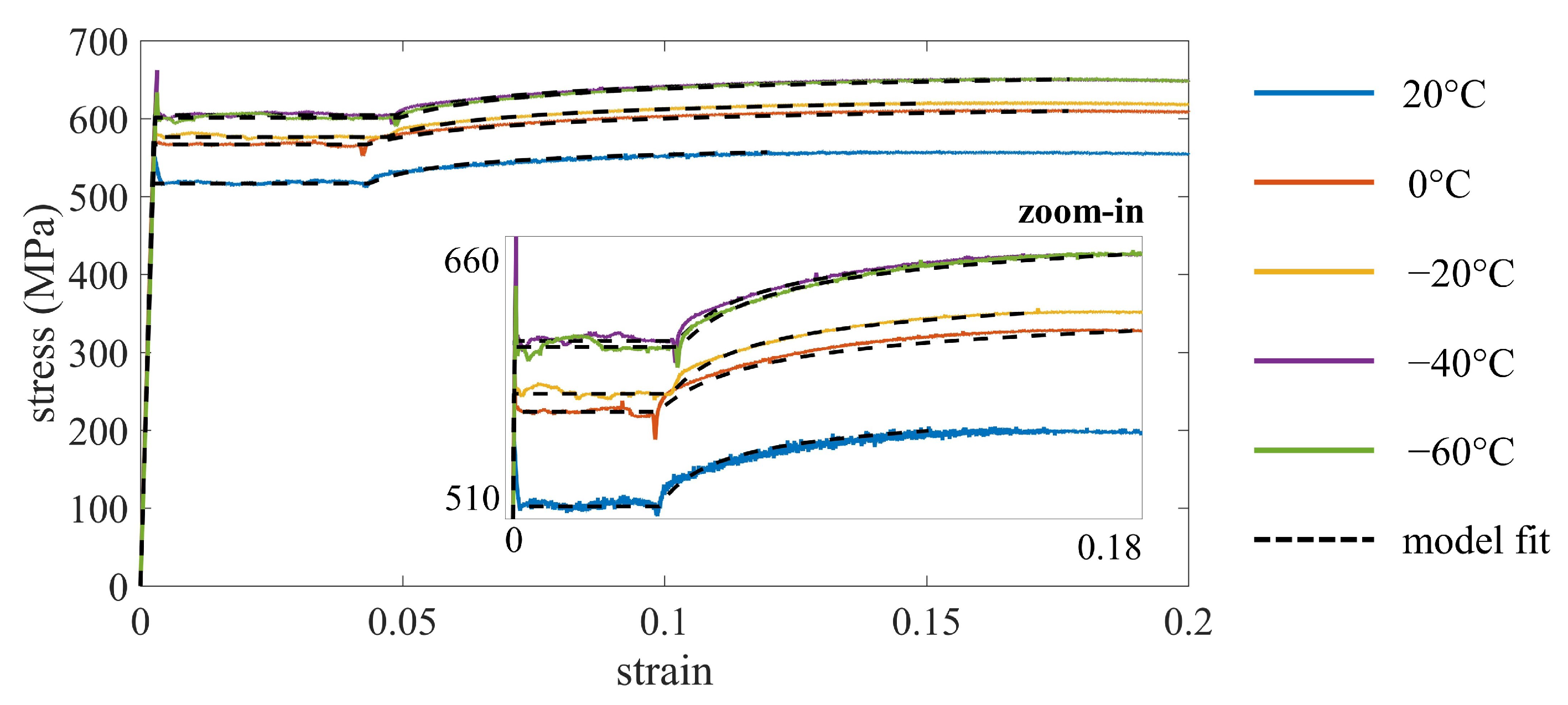
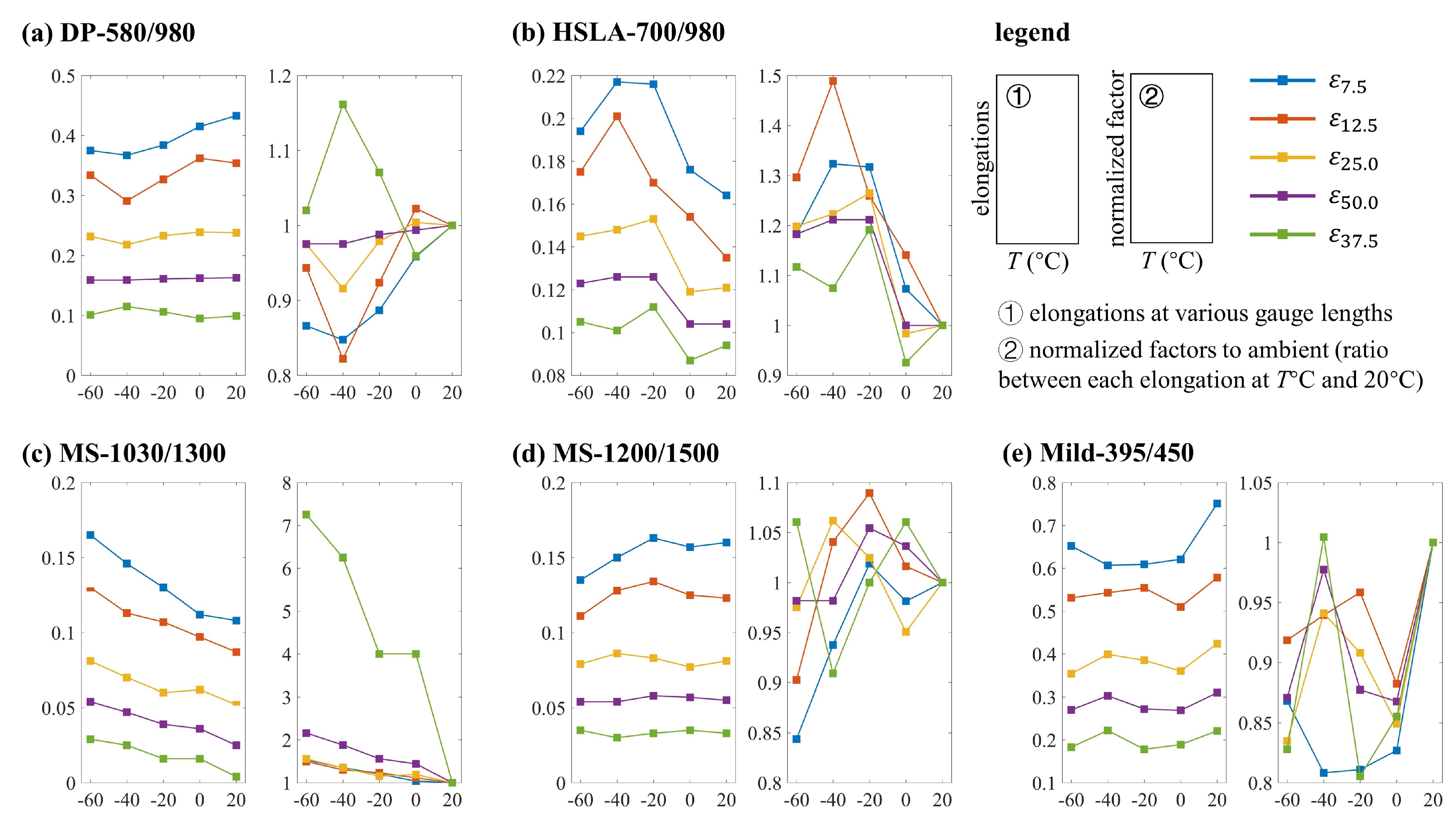


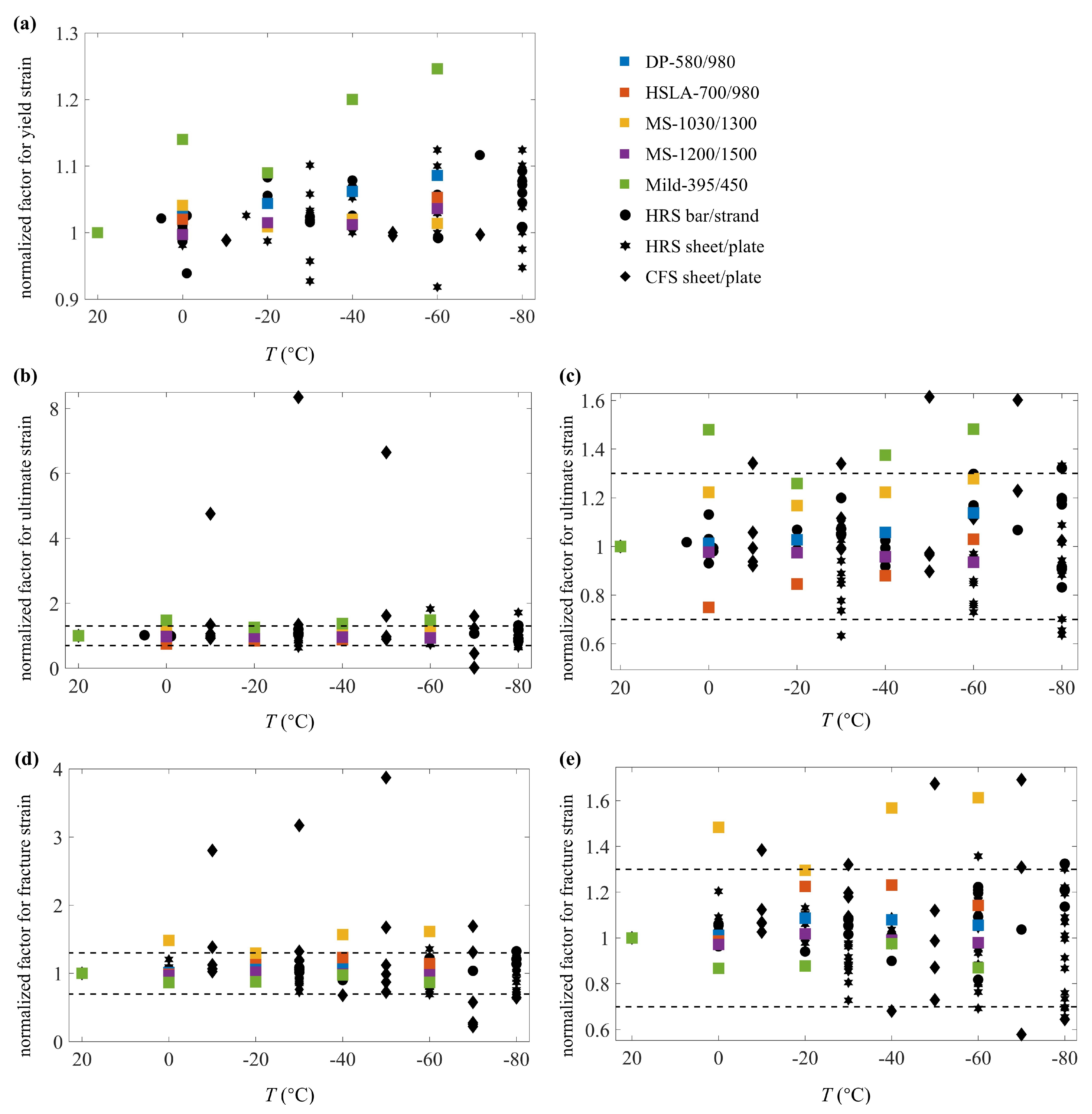
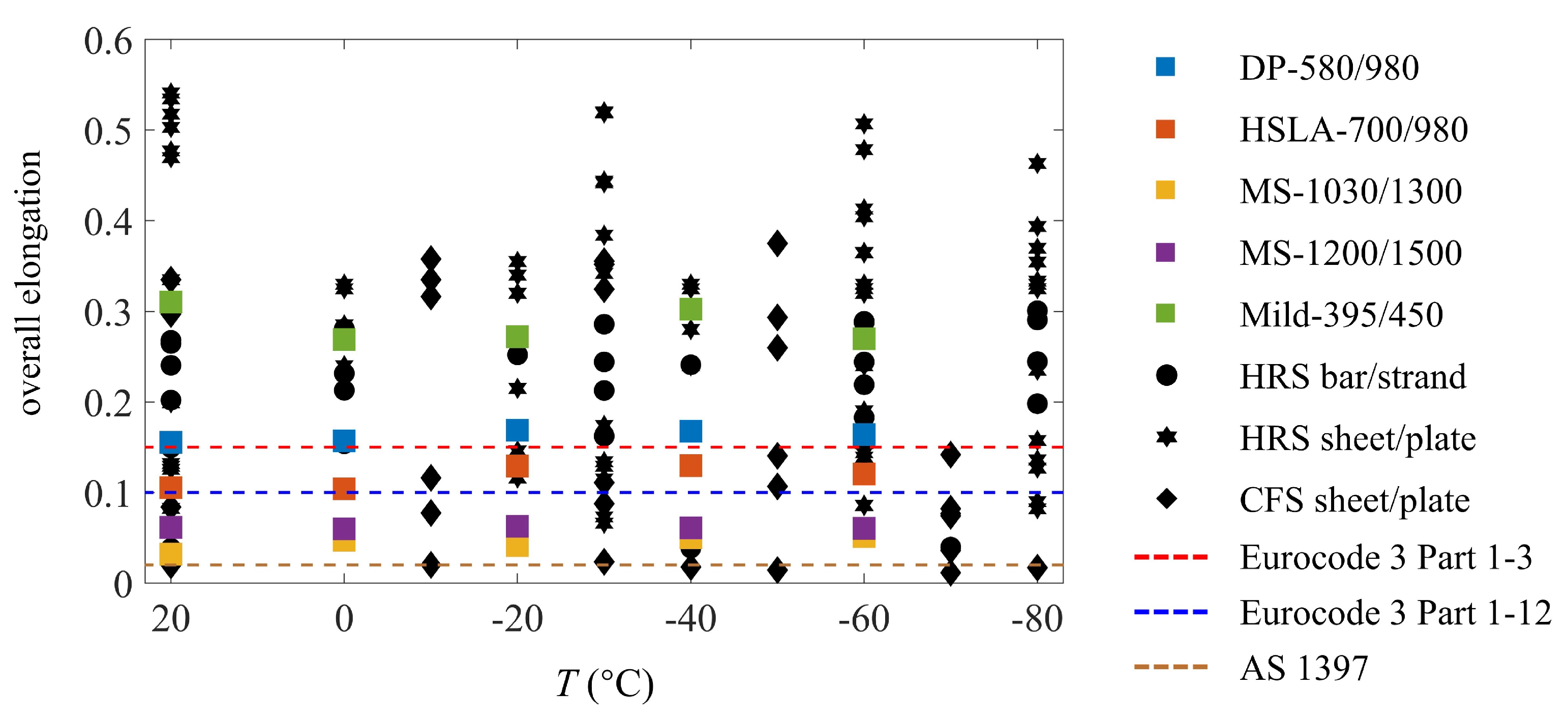
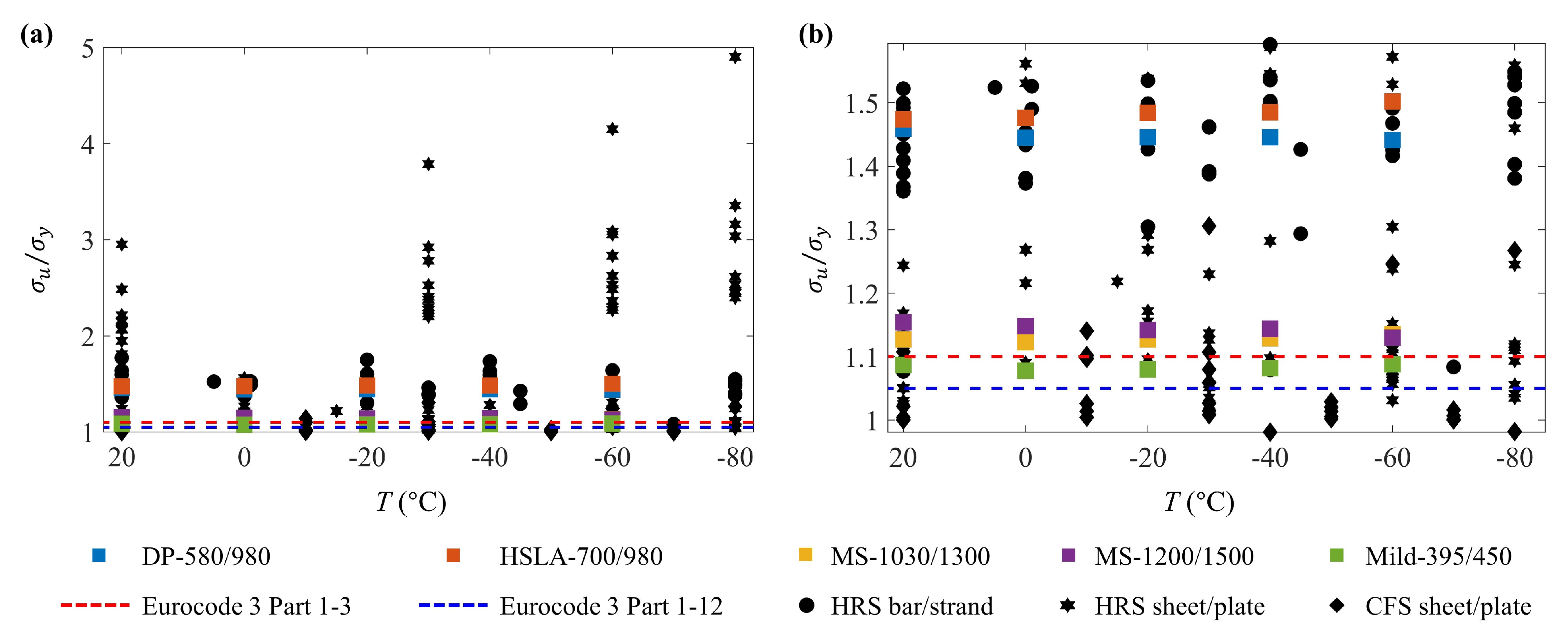
| Element | DP-580/980 | HSLA-700/980 | MS-1030/1300 | MS-1200/1500 | Mild-395/450 |
|---|---|---|---|---|---|
| C | 0.167 | 0.104 | 0.16 | 0.28 | 0.04 |
| Si | 1.413 | 0.012 | 0.4 | 0.4 | 0.02 |
| Mn | 2.0 | 2.32 | 1.8 | 1.3 | 0.65 |
| P | 0.01 | 0.013 | 0.02 | 0.02 | 0.015 |
| S | 0.002 | 0.004 | 0.01 | 0.01 | 0.003 |
| Al | 0.047 | 0.031 | 0.015 | 0.015 | 0.025 |
| Nb + Ti | 0.006 | - | 0.1 | 0.1 | 0.018 |
| Cr + Mo | 0.043 | 0.606 | 1.0 | 1.0 | 0.08 |
| V | 0.005 | 0.001 | - | - | 0.002 |
| B | 0.0003 | 0.0001 | 0.005 | 0.01 | - |
| Cu | 0.02 | 0.02 | 0.2 | 0.2 | 0.09 |
| Ni | 0.01 | 0.01 | - | - | 0.03 |
| Sn | 0.008 | 0.002 | - | - | 0.005 |
| N | 0.004 | 0.005 | - | - | 0.008 |
| Cb | 0.003 | 0.002 | - | - | - |
| Sb | - | 0.001 | - | - | - |
| Ca | - | 0.001 | - | - | 0.002 |
| Steel | (mm) | (MPa) | (MPa) | Coating |
|---|---|---|---|---|
| Mild-395/450 | 1.8 | 395 | 450 | uncoated |
| DP-580/980 | 1.8 | 580 | 980 | uncoated |
| HSLA-700/980 | 0.6 | 700 | 980 | zinc-coated |
| MS-1030/1300 | 1.0 | 1030 | 1300 | uncoated |
| MS-1200/1500 | 1.0 | 1200 | 1500 | uncoated |
| Specimen | b | t | ||||||||
|---|---|---|---|---|---|---|---|---|---|---|
| mm | mm | GPa | MPa | % | MPa | MPa | % | MPa | % | |
| Mild-395/450+20-1 | 12.92 | 1.905 | 226.7 | 514.4 | 0.427 | 516.2 | 559.1 | 11.97 | - | 31.04 |
| Mild-395/450-0-1 | 12.86 | 1.912 | 218.1 | 566.8 | 0.460 | 567.4 | 611.1 | 17.71 | - | 26.90 |
| Mild-395/450-20-1 | 12.83 | 1.905 | 231.9 | 575.7 | 0.449 | 576.0 | 621.8 | 15.05 | - | 27.22 |
| Mild-395/450-40-1 | 12.86 | 1.908 | 220.9 | 601.7 | 0.472 | 605.9 | 651.2 | 16.45 | - | 30.26 |
| Mild-395/450-60-1 | 12.89 | 1.910 | 211.7 | 600.0 | 0.483 | 606.3 | 652.7 | 17.73 | - | 26.98 |
| DP-580/980+20-1 | 12.94 | 1.804 | 213.2 | 750.5 | 0.552 | 985.6 | 1095.5 | 9.84 | 967.5 | 14.84 |
| DP-580/980+20-2 | 12.91 | 1.822 | 216.6 | 752.5 | 0.548 | 982.3 | 1097.0 | 10.53 | 964.0 | 16.22 |
| DP-580/980-0-1 | 12.95 | 1.820 | 212.9 | 785.2 | 0.569 | 1019.6 | 1137.2 | 10.92 | 1005.3 | 15.32 |
| DP-580/980-0-2 | 12.96 | 1.806 | 215.5 | 788.6 | 0.566 | 1016.6 | 1136.3 | 9.72 | 963.6 | 16.10 |
| DP-580/980-20-1 | 12.94 | 1.810 | 218.0 | 789.4 | 0.562 | 1023.2 | 1143.7 | 9.89 | 998.3 | 16.05 |
| DP-580/980-20-2 | 12.93 | 1.833 | 207.4 | 798.8 | 0.585 | 1027.6 | 1153.0 | 11.05 | 1013.3 | 17.69 |
| DP-580/980-40-1 | 12.91 | 1.832 | 212.0 | 826.5 | 0.590 | 1056.9 | 1195.5 | 11.77 | 1042.8 | 16.89 |
| DP-580/980-40-2 | 12.97 | 1.815 | 214.0 | 808.2 | 0.577 | 1039.8 | 1167.9 | 9.77 | 1039.0 | 16.64 |
| DP-580/980-60-1 | 12.94 | 1.830 | 210.0 | 846.5 | 0.603 | 1074.1 | 1218.4 | 11.97 | 1071.5 | 16.29 |
| DP-580/980-60-2 | 12.95 | 1.816 | 214.7 | 840.4 | 0.592 | 1070.9 | 1212.9 | 11.22 | 1061.0 | 16.51 |
| HSLA-700/980+20-1 | 12.70 | 0.590 | 203.6 | 767.0 | 0.577 | 1033.2 | 1127.7 | 8.91 | 1112.1 | 10.17 |
| HSLA-700/980+20-2 | 12.70 | 0.591 | 202.4 | 758.2 | 0.575 | 1023.9 | 1119.9 | 10.62 | 1103.7 | 10.91 |
| HSLA-700/980-0-1 | 12.73 | 0.589 | 199.8 | 772.6 | 0.587 | 1037.2 | 1137.9 | 7.65 | 1127.5 | 10.23 |
| HSLA-700/980-0-2 | 12.75 | 0.584 | 197.6 | 764.5 | 0.587 | 1031.0 | 1130.6 | 6.98 | 1117.3 | 10.57 |
| HSLA-700/980-20-1 | 12.80 | 0.581 | 199.7 | 760.4 | 0.581 | 1021.7 | 1132.4 | 8.00 | 1096.0 | 12.96 |
| HSLA-700/980-20-2 | 12.76 | 0.591 | 203.2 | 779.3 | 0.583 | 1049.3 | 1152.0 | 8.54 | 1103.7 | 12.86 |
| HSLA-700/980-40-1 | 12.71 | 0.593 | 202.4 | 782.0 | 0.586 | 1055.5 | 1162.5 | 8.68 | 1123.9 | 12.73 |
| HSLA-700/980-40-2 | 12.76 | 0.585 | 202.2 | 779.6 | 0.585 | 1048.0 | 1155.7 | 8.50 | 1093.9 | 13.21 |
| HSLA-700/980-60-1 | 12.73 | 0.597 | 198.9 | 798.6 | 0.601 | 1070.9 | 1187.0 | 9.85 | 1134.2 | 13.40 |
| HSLA-700/980-60-2 | 12.79 | 0.598 | 194.2 | 798.6 | 0.611 | 1083.8 | 1212.7 | 10.26 | 1205.9 | 10.66 |
| MS-1030/1300+20-1 | 12.63 | 0.991 | 215.9 | 1333.0 | 0.817 | 1484.1 | 1493.3 | 2.49 | 1196.2 | 2.48 |
| MS-1030/1300+20-2 | 12.62 | 0.992 | 208.0 | 1317.1 | 0.833 | 1477.9 | 1492.7 | 2.77 | 1199.6 | 3.91 |
| MS-1030/1300-0-1 | 12.63 | 0.990 | 201.6 | 1332.3 | 0.861 | 1479.6 | 1498.1 | 3.47 | 1220.0 | 5.04 |
| MS-1030/1300-0-2 | 12.62 | 0.991 | 202.4 | 1329.6 | 0.857 | 1477.4 | 1491.9 | 2.95 | 1143.9 | 4.44 |
| MS-1030/1300-20-1 | 12.58 | 0.993 | 216.4 | 1323.0 | 0.811 | 1479.9 | 1497.8 | 3.25 | 1172.6 | 5.06 |
| MS-1030/1300-20-2 | 12.65 | 0.990 | 205.9 | 1347.4 | 0.854 | 1496.4 | 1511.4 | 2.90 | 1182.5 | 3.22 |
| MS-1030/1300-40-1 | 12.56 | 0.985 | 209.9 | 1343.1 | 0.840 | 1499.2 | 1517.9 | 3.22 | 1199.4 | 5.03 |
| MS-1030/1300-40-2 | 12.54 | 0.986 | 208.4 | 1341.9 | 0.844 | 1496.5 | 1513.1 | 3.21 | 1153.2 | 4.99 |
| MS-1030/1300-60-1 | 12.54 | 0.985 | 215.0 | 1348.4 | 0.827 | 1505.5 | 1524.1 | 3.40 | 1177.2 | 5.15 |
| MS-1030/1300-60-2 | 12.63 | 0.988 | 206.4 | 1335.4 | 0.847 | 1501.0 | 1521.7 | 3.32 | 1173.5 | 5.16 |
| MS-1200/1500+20-1 | 12.53 | 1.010 | 204.6 | 1401.6 | 0.885 | 1578.4 | 1620.3 | 4.15 | 1282.3 | 6.16 |
| MS-1200/1500+20-2 | 12.57 | 1.003 | 199.6 | 1412.5 | 0.908 | 1584.1 | 1626.4 | 4.03 | 1282.5 | 6.15 |
| MS-1200/1500-0-1 | 12.58 | 1.006 | 208.6 | 1442.4 | 0.892 | 1620.0 | 1660.7 | 4.02 | 1301.2 | 6.05 |
| MS-1200/1500-0-2 | 12.60 | 0.996 | 208.5 | 1452.1 | 0.896 | 1622.7 | 1661.5 | 3.97 | 1307.4 | 5.90 |
| MS-1200/1500-20-1 | 12.63 | 1.000 | 203.2 | 1452.5 | 0.915 | 1619.5 | 1660.0 | 4.05 | 1322.9 | 5.84 |
| MS-1200/1500-20-2 | 12.60 | 1.007 | 206.5 | 1457.6 | 0.905 | 1625.4 | 1664.7 | 3.92 | 1275.4 | 6.68 |
| MS-1200/1500-40-1 | 12.63 | 1.011 | 205.7 | 1450.1 | 0.905 | 1615.0 | 1652.8 | 3.71 | 1253.1 | 5.86 |
| MS-1200/1500-40-2 | 12.47 | 1.008 | 204.8 | 1451.6 | 0.909 | 1623.9 | 1665.6 | 4.11 | 1295.3 | 6.33 |
| MS-1200/1500-60-1 | 12.56 | 0.992 | 207.9 | 1495.8 | 0.919 | 1637.0 | 1669.4 | 3.45 | 1288.8 | 5.64 |
| MS-1200/1500-60-2 | 12.58 | 1.011 | 198.6 | 1464.1 | 0.937 | 1633.5 | 1675.5 | 4.19 | 1350.9 | 6.41 |
| T | 20 C | 0 C | −20 C | −40 C | −60 C |
|---|---|---|---|---|---|
| (MPa) | 517.0 | 566.8 | 576.5 | 604.2 | 601.2 |
| (MPa) | 555.9 | 591.2 | 625.6 | 662.3 | 633.7 |
| (%) | 0.228 | 0.260 | 0.249 | 0.274 | 0.284 |
| (%) | 4.36 | 4.32 | 4.70 | 4.87 | 4.95 |
Disclaimer/Publisher’s Note: The statements, opinions and data contained in all publications are solely those of the individual author(s) and contributor(s) and not of MDPI and/or the editor(s). MDPI and/or the editor(s) disclaim responsibility for any injury to people or property resulting from any ideas, methods, instructions or products referred to in the content. |
© 2023 by the authors. Licensee MDPI, Basel, Switzerland. This article is an open access article distributed under the terms and conditions of the Creative Commons Attribution (CC BY) license (https://creativecommons.org/licenses/by/4.0/).
Share and Cite
Xia, Y.; Blum, H.B. Subzero Material Properties of Advanced High-Strength Cold-Formed Steel Alloys. Buildings 2023, 13, 399. https://doi.org/10.3390/buildings13020399
Xia Y, Blum HB. Subzero Material Properties of Advanced High-Strength Cold-Formed Steel Alloys. Buildings. 2023; 13(2):399. https://doi.org/10.3390/buildings13020399
Chicago/Turabian StyleXia, Yu, and Hannah B. Blum. 2023. "Subzero Material Properties of Advanced High-Strength Cold-Formed Steel Alloys" Buildings 13, no. 2: 399. https://doi.org/10.3390/buildings13020399
APA StyleXia, Y., & Blum, H. B. (2023). Subzero Material Properties of Advanced High-Strength Cold-Formed Steel Alloys. Buildings, 13(2), 399. https://doi.org/10.3390/buildings13020399







